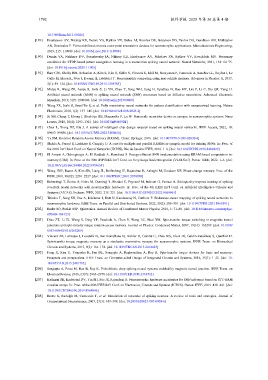Page 386 - 《软件学报》2025年第4期
P. 386
1792 软件学报 2025 年第 36 卷第 4 期
10.3389/fnins.2011.00026]
[189] Emelyanov AV, Nikiruy KE, Demin VA, Rylkov VV, Belov AI, Korolev DS, Gryaznov EG, Pavlov DA, Gorshkov ON, Mikhaylov
AN, Dimitrakis P. Yttria-stabilized zirconia cross-point memristive devices for neuromorphic applications. Microelectronic Engineering,
2019, 215: 110988. [doi: 10.1016/j.mee.2019.110988]
[190] Demin VA, Nekhaev DV, Surazhevsky IA, Nikiruy KE, Emelyanov AV, Nikolaev SN, Rylkov VV, Kovalchuk MV. Necessary
conditions for STDP-based pattern recognition learning in a memristive spiking neural network. Neural Networks, 2021, 134: 64–75.
[doi: 10.1016/j.neunet.2020.11.005]
[191] Burr GW, Shelby RM, Sebastian A, Kim S, Kim S, Sidler S, Virwani K, Ishii M, Narayanan P, Fumarola A, Sanches LL, Boybat I, Le
Gallo M, Moon K, Woo J, Hwang H, Leblebici Y. Neuromorphic computing using non-volatile memory. Advances in Physics: X, 2017,
2(1): 89–124. [doi: 10.1080/23746149.2016.1259585]
[192] Midya R, Wang ZR, Asapu S, Joshi S, Li YN, Zhuo Y, Song WH, Jiang H, Upadhay N, Rao MY, Lin P, Li C, Xia QF, Yang JJ.
Artificial neural network (ANN) to spiking neural network (SNN) converters based on diffusive memristors. Advanced Electronic
Materials, 2019, 5(9): 1900060. [doi: 10.1002/aelm.201900060]
[193] Wang ZR, Joshi S, Savel’Ev S, et al. Fully memristive neural networks for pattern classification with unsupervised learning. Nature
Electronics, 2018, 1(2): 137–145. [doi: 10.1038/s41928-018-0023-2]
[194] Jo SH, Chang T, Ebong I, Bhadviya BB, Mazumder P, Lu W. Nanoscale memristor device as synapse in neuromorphic systems. Nano
Letters, 2010, 10(4): 1297–1301. [doi: 10.1021/nl904092h]
[195] Chen L, Xiong XZ, Liu J. A survey of intelligent chip design research based on spiking neural networks. IEEE Access, 2022, 10:
89663–89686. [doi: 10.1109/ACCESS.2022.3200454]
[196] Yu SM. Resistive Random Access Memory (RRAM). Cham: Springer, 2016. [doi: 10.1007/978-3-031-02030-8]
[197] Shukla A, Prasad S, Lashkare S, Ganguly U. A case for multiple and parallel RRAMs as synaptic model for training SNNs. In: Proc. of
the 2018 Int’l Joint Conf. on Neural Networks (IJCNN). Rio de Janeiro: IEEE, 2018. 1–8. [doi: 10.1109/IJCNN.2018.8489429]
[198] El Arrassi A, Gebregiorgis A, El Haddadi A, Hamdioui S. Energy-efficient SNN implementation using RRAM-based computation in-
memory (CIM). In: Proc. of the 30th IFIP/IEEE Int’l Conf. on Very Large Scale Integration (VLSI-SoC). Patras: IEEE, 2022. 1–6. [doi:
10.1109/VLSI-SoC54400.2022.9939654]
[199] Wong HSP, Raoux S, Kim SB, Liang JL, Reifenberg JP, Rajendran B, Asheghi M, Goodson KE. Phase change memory. Proc. of the
IEEE, 2010, 98(12): 2201–2227. [doi: 10.1109/JPROC.2010.2070050]
[200] Bohnstingl T, Šurina A, Fabre M, Demirağ Y, Frenkel C, Payvand M, Indiveri G, Pantazi A. Biologically-inspired training of spiking
recurrent neural networks with neuromorphic hardware. In: Proc. of the 4th IEEE Int’l Conf. on Artificial Intelligence Circuits and
Systems (AICAS). Incheon: IEEE, 2022. 218–221. [doi: 10.1109/AICAS54282.2022.9869963]
[201] Titirsha T, Song SH, Das A, Krichmar J, Dutt N, Kandasamy N, Catthoor F. Endurance-aware mapping of spiking neural networks to
neuromorphic hardware. IEEE Trans. on Parallel and Distributed Systems, 2022, 33(2): 288–301. [doi: 10.1109/TPDS.2021.3065591]
[202] Bader SD, Parkin SSP. Spintronics. Annual Review of Condensed Matter Physics, 2010, 1: 71–88. [doi: 10.1146/annurev-conmatphys-
070909-104123]
[203] Diao ZT, Li ZJ, Wang S, Ding YF, Panchula A, Chen E, Wang LC, Huai YM. Spin-transfer torque switching in magnetic tunnel
junctions and spin-transfer torque random access memory. Journal of Physics: Condensed Matter, 2007, 19(16): 165209. [doi: 10.1088/
0953-8984/19/16/165209]
[204] Vincent AF, Larroque J, Locatelli N, Ben Romdhane N, Bichler O, Gamrat C, Zhao WS, Klein JO, Galdin-Retailleau S, Querlioz D.
Spin-transfer torque magnetic memory as a stochastic memristive synapse for neuromorphic systems. IEEE Trans. on Biomedical
Circuits and Systems, 2015, 9(2): 166–174. [doi: 10.1109/TBCAS.2015.2414423]
[205] Fong X, Kim Y, Yogendra K, Fan DL, Sengupta A, Raghunathan A, Roy K. Spin-transfer torque devices for logic and memory:
Prospects and perspectives. IEEE Trans. on Computer-aided Design of Integrated Circuits and Systems, 2016, 35(1): 1–22. [doi: 10.
1109/TCAD.2015.2481793]
[206] Sengupta A, Parsa M, Han B, Roy K. Probabilistic deep spiking neural systems enabled by magnetic tunnel junction. IEEE Trans. on
Electron Devices, 2016, 63(7): 2963–2970. [doi: 10.1109/TED.2016.2568762]
[207] Kulkarni SR, Kadetotad DV, Yin SH, Seo JS, Rajendran B. Neuromorphic hardware accelerator for SNN inference based on STT-RAM
crossbar arrays. In: Proc. of the 26th IEEE Int’l Conf. on Electronics, Circuits and Systems (ICECS). Genoa: IEEE, 2019. 438–441. [doi:
10.1109/ICECS46596.2019.8964886]
[208] Brette R, Rudolph M, Carnevale T, et al. Simulation of networks of spiking neurons: A review of tools and strategies. Journal of
Computational Neuroscience, 2007, 23(3): 349–398. [doi: 10.1007/s10827-007-0038-6]

